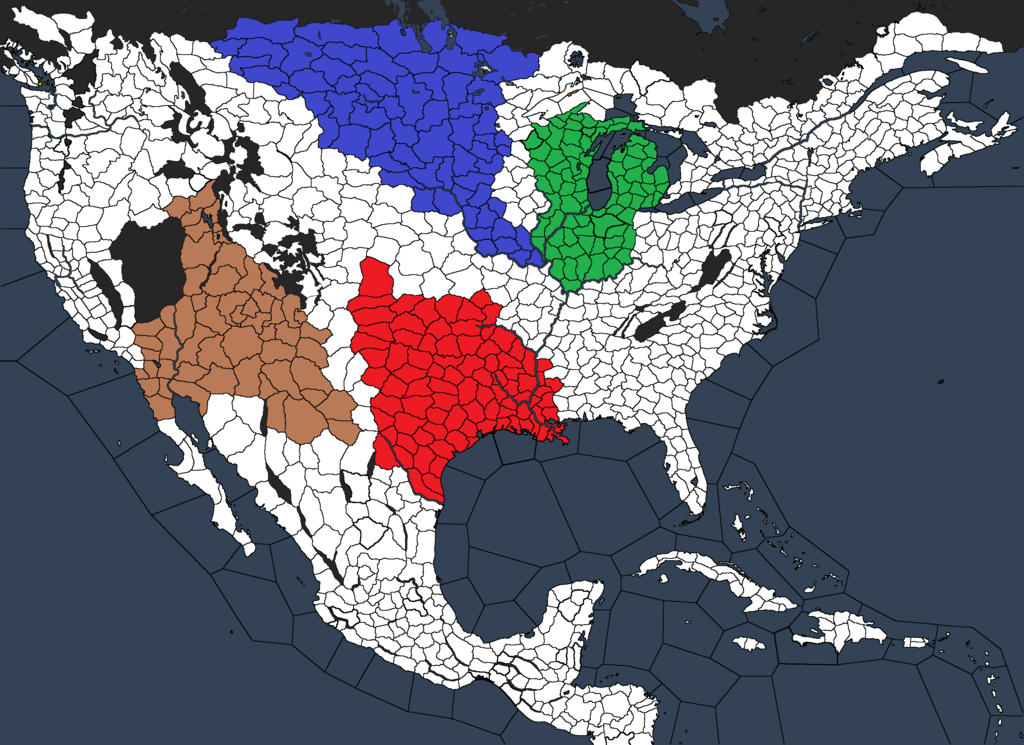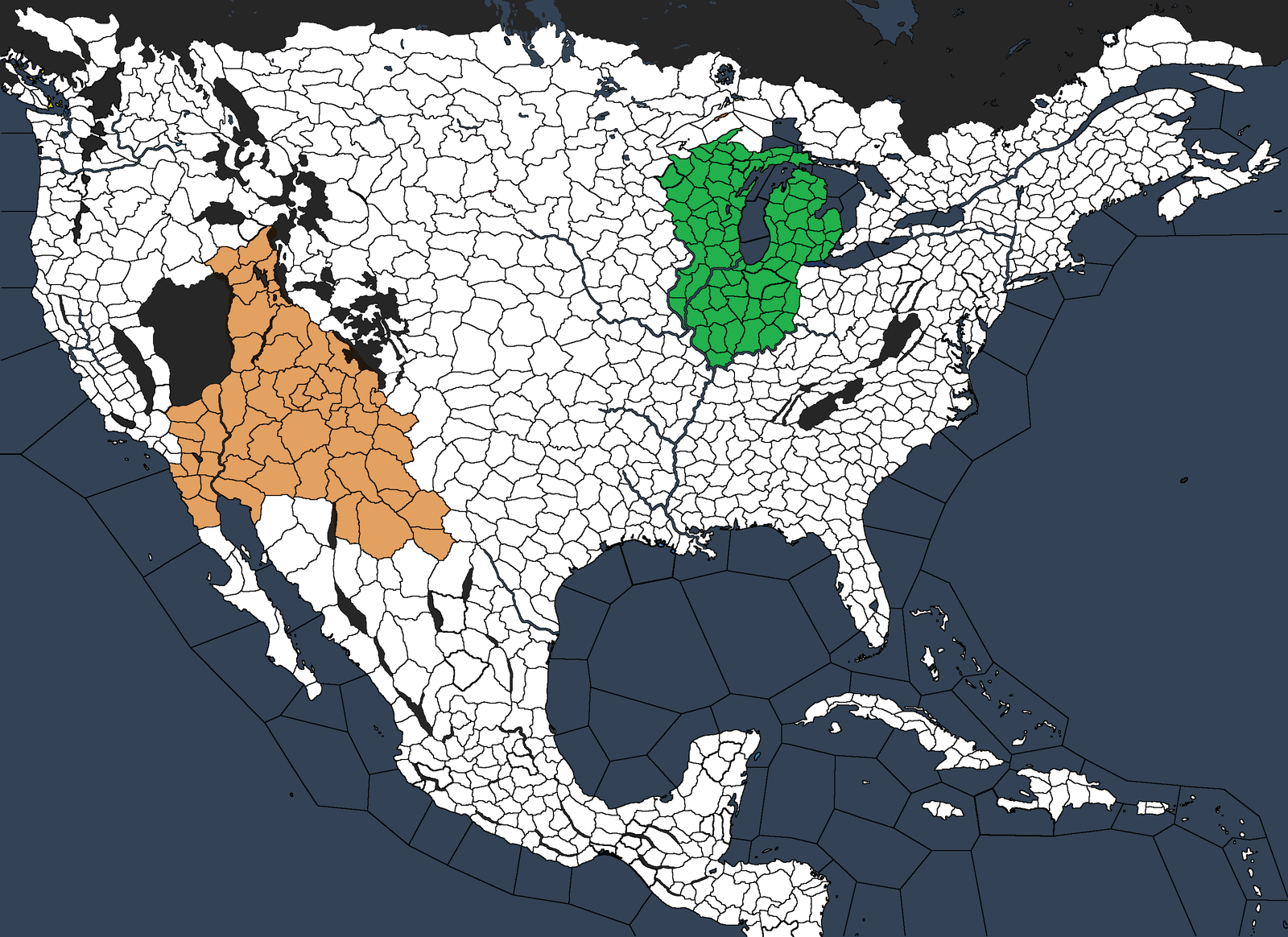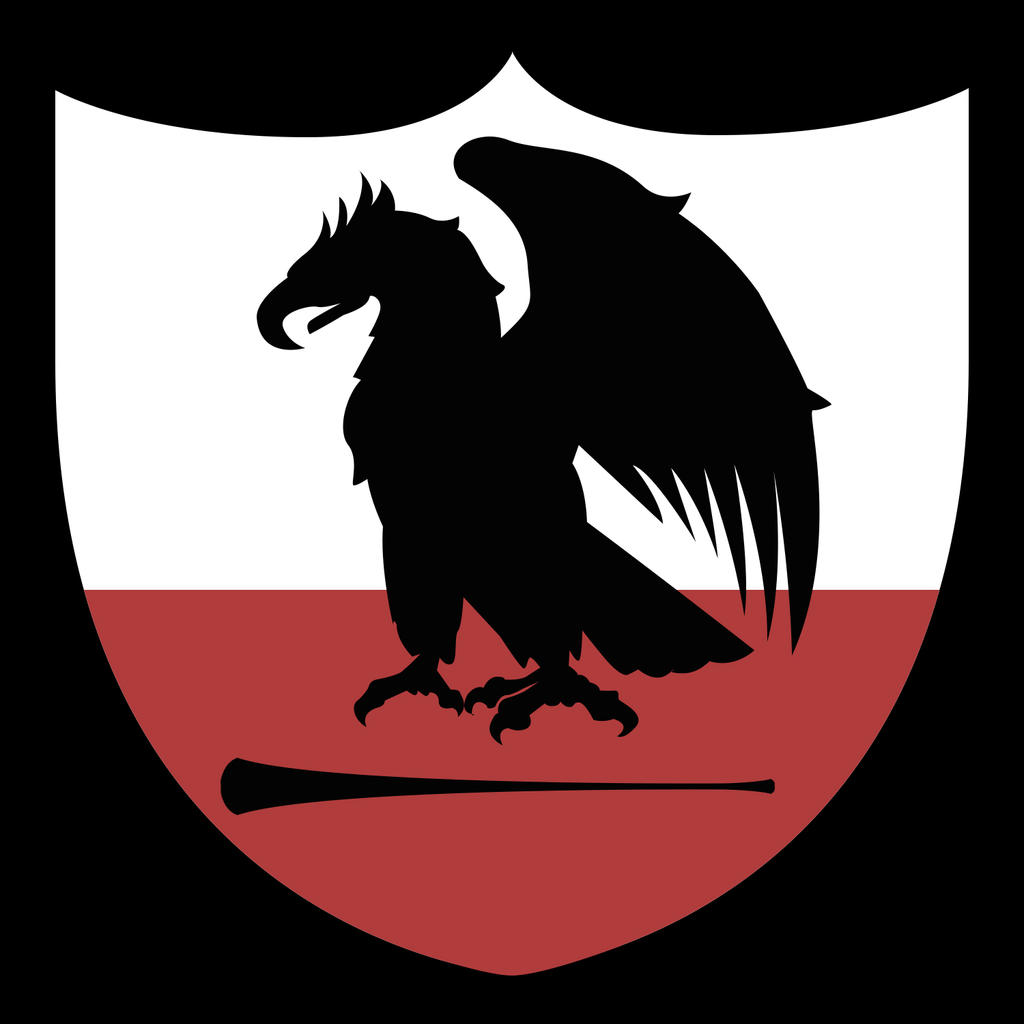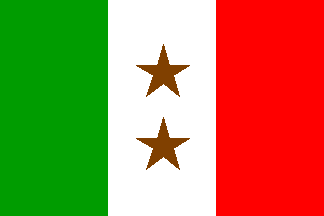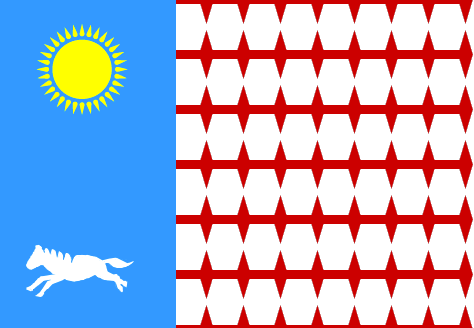The Caliphate of Chicago

The Caliphate of Chicago is a government based in the teachings of Islam (or at least the form of Islam that has come into existence in the post-war Americas), as dictated by the restored Qur'an. In addition to the Qur'an, the government has had influences from the traditional divisions of power found among the Tribesmen of Illinois and Lower Michigan. Coming from a people who were largely semi-nomadic, and farmed the many tributaries of the Mississippi, as well as the Great Lakes, they had a very advanced system of law and governance that has contributed much to the Caliphate. Some influence from the Tribal Law includes division of land ownership, traditions of payment by employers to his workers, and the division of power into tripartite tribal courts.
Further north, in Wisconsin, the government is largely autonomous and decided by the native Nordic Tribes. Due to the presence of the native Nordic Religion, and the Caliphate's willingness to accept the Norsemen's faith so long as they make regular payments of Tribute to the Caliph, the way of life is much more rooted in Nord traditions.
Leader(s):Caliph Yusuf ibn Mikhail ibn Jayrard al-DatruyatiCaliph Yusuf is a descendant of an indigenous tribe native to the Detroit region of Michigan and the 4th Caliph. His people are a fairly recent conquest, however, his tribe, the Bootmen, were willing to convert to Islam to keep their position as rulers over the city of Detroit. Caliph Yusuf is a descendant of the Restorer, 'Iskandar as-Sayf, on his paternal lineage, which aided in his bid for Caliphate. Yusuf is sometimes known as the "Poet King" due to his fondness for the arts of the word and pen, and has a fairly good reputation among his people, and has strengthened Michigani pride, with one of their own on the Throne.
Culture:Following the Uniting of Illinois under Iskandar as-Sayf, the national language, and the lingua franca of the Caliphate has been Arabic, as it was reconstructed by associates of Iskandar from books found in the libraries of Mosques that he searched for the pages of the Qu'ran in, as well as from the wording of bilingual Qu'rans themselves.
The Nation is largely divided into 3 similar, but distinct groups, the Illinoyi, the Michigani, and the Norsemen. Perhaps the most similar are the Illinoyi and the Michigani. Both were for the most part, semi-nomadic people living in areas controlled by the more powerful city-states,controlled by City-Tribes. Following the establishment of Alexandar's Caliphate, Islam, in its restored form, came to dominate over the territory. The tribes of the Illinoi converted fairly quickly, while full Islamization of the Michigani is slowly coming, with 70% of Michigan following the religion to some extent.
To the North are the Norsemen, the descendants of the people of Wisconsin, Minnesota, and the Upper Peninsula. They are a much more tribal people, with their own religion, their own much more distinct culture, and their own language, Nordic, a descendant of Midwestern English, though very simplified and with its own grammar and new words. Norsemen are a warrior culture, who have long controlled the Mississippi River and used it to raid the tribes living along it and its tributaries. When they finally came under the control of the Caliphate, they were given the right to continue their raiding, under the condition that they give 5% of their raiding goods to the Caliph as Tribute.
Demographics:52% Illinoyi
22% Michigani
26% Nordic
68% Islam
20% Tribal Religions
12% Ahl al-Kitab (The various old Christian and Jewish denominations found in the Midwest before the war)
Nation History:The History of the Caliphate begins with that of the Warheads Tribe, and in particular, the Czupowski clan. Of these people, native to the land of Illinois, were cattle herdsmen who wandered in between the great Lake of Michigan, and the waters of the Mississippi, but found themselves often subject to raids by the more powerful and warlike Nordic Tribes who sailed the Mississipi and it's tributaries. The Warheads were a rather destitute little tribe, and often took refuge in the ruins of old cities and towns. One member of this tribe was a young man named Alexander Czupowski, who liked to explore the ruins of buildings that he liked the sight of. While exploring the ruins of a domed building marked by strange writting and the remains of a tall tower, Alexander fell through the floor and into a room filled with books. Alexander had previously learned to read, as a result of his adventures, but found he could not understand much of the text in these books. However, he found among the books that he could read, remnants of a faith that he found much to admire in. He found in this burnt-out mosque as well, a book detailing the basic tenants of the faith of submission, a half-burned book teaching basic Arabic, and a burnt out Quran with the 3 Juz and a half still legible. Alexander took them with him. And sought to complete the book, as shown by the directory of surahs in the text he had. Later Generations would refer to this discovery as the first revelation.
At this time, Alexander shared not his discovery of the text but continued to meditate on the words he found in the ancient tome and study the writings that would help to teach him the Arabic language and alphabet. Within 2 months of the first revelation, Alexander had a decent knowledge of the Arabic language. He continued his plundering of former Mosques, though while he was collecting the lost pieces of his text, the tribes of the Illinoyi were falling under the control of a powerful tribal confederation, the Miracles.
The Miracles were a collection of several powerful tribes in the area of Illinois and some tribes from the North Way. They had established power over other tribes through religious means, taking control of sacred sites to the Illinoyi to gain power through profit of pilgrimage and the social status controlling these sites held. In the time of the rise of The Miracles, and their solidification of control, Alexander had reached the age of 33 and had found half of the total Quran. In this timespan, Alexander had begun to preach the message of this ancient book, speaking of one god, and a complete way of life that he had created for the people. Men from all over Illinois flocked to see this strange preacher.
Madman, Blasphemer, Prophet, Restorer; all words that those who came to see Alexander used to describe him. However Alexander only described himself as "a servant of the one god"
Needless to say, the sudden rise in a foreign religion, spread by a scavenger from an unremarkable clan in a worthless tribe caught the attention of the Miracles, who came to the Warheads and demanded that they take care of the rogue preacher and his followers, or face consequences.
Thus began the Night of Sorrow, wherein, the leaders of the Warheads came upon the gathering of Muslims and attacked, killing many and taking others to be executed by the Miracles. The prisoners were taken back, where they were skinned alive, and placed, nailed into wooden poles around the holy shrine of the Mirror Dome in Holy Chicago. Alexander and his surviving followers were horrified, and realized that they could not live in Illinois any longer, and thus, decied to take upon them a migration, to the land of Michigan.
Michigan was sufficiently far from the long arm of the Miracles, a different people of a different culture, but similar enough to relate to. Thus began the migration, as the Muslims left and traveled east to Michigan. Therein, they found a land of machines and gears, a people less agricultural than themselves, living in tribes centered around the City, each fighting and decorating themselves in cogs, steel, rust, and Gears. The Muslims found themselves attacked and dispersed by the powerful Mod Tribe, who drove them further north, to a city taboo among the Michigani tribes. The City had no name, though it was informally known as the Dwelling of the Deer. In this place, the Muslims would find an unlikely ally. Alexander found himself connecting with a people known as the Hanifs, a group of semi-monastic monotheists, who were found to be practicing from the same text that Alexander himself. With the aid of the Hanifs, Alexander completed the Quran, and united his followers and the ancient people, establishing a state based out of the city of Deer. The Deer Caliphate fought hard, first wrestling control of the territory of the Mods, the same people who attacked and dispersed the migrants. They were met with a similar fate, being decimated and dispersed. Conquering tribe and city one after the other. Soon, all of Michigan had come under their control, and Alexander turned his attention towards Illinois.
With little organization, the armies of the caliphate swept over, taking tribe by tribe under their control, and making their way back to Chicago, where Alexander himself approached the holy shrine, and purified it, destroying all traces of the Miracles' cult of personality, and officially disbanding and outlawing the tribe. The Cloud Gate was designated as the New Kaaba, as the previous was unknown, and would be the new center of Hajj. The people rejoiced, and Alexander earned the title of As-Sayf.
There came again, a problem with the north.
Although they had been a problem for all known time, the River raiders of the North were increasing their ferocity with the newfound wealth, power, and security that the unified caliphate brought to the Midwest. With the wealthy, open plains dotted by the cities of Illinois made the raids by the Norsemen rather common. Following the movement of wars against the tribes of the north, the Caliph made a deal with the Norsemen, allowing them to practice their animistic religion in peace and raid the lands of outsiders, so long as they were willing to pay regular tribute and pledge allegiance to the Caliphate. The Norsemen proved a valuable asset, and one of the Later Caliphs took to the practice of enlisting Norse converts to Islam as his personal bodyguards.
The Caliphate has taken steps in modernization, such as taking advantage of sedentary farming of the river plains, and moving towards sedentary lifestyle, by routing irrigation systems from the larger tributaries. Steadily, the nation has been growing in power.
Description of Economy:
The Economy of The Caliphate comes from various sources, such as crafts being made and sold in the urban areas, as well as money earned through trading with neighboring countries through trade caravans. As well, the raids being done by the Norse has accumulated a nice supplement to the income of the cities and producers in city areas.
Agriculture and Raiding is found mostly in the Northern Areas, particularly the Northwoods and Michigan.
Weapons production is centered around the cities of Daytruyat and Shamsul-Gharb. It is said the best swords come from Indiana, and the best guns from Michigan.
Territory and Description of Environment:
 The Rebuilt Holy City of Chicago
The Rebuilt Holy City of ChicagoThe Enviroment of the Caliphate centers around the Flatlands and the Northwoods, with the former comprising most of the South, and inhabited mostly by urban dwellers, farmers, and Muslims, while the Northwoods is primarly inhabited by Norsemen, farmers and raiders living in close proximity to rivers.
The climate consists of hot, humid summers, and cold, harsh winters. Farming starts with the thawing of spring and ends with harvest at autumn. Farther north, the climate gets even colder, with corn and soy farming being the predominate form of agriculture, supplimented by hunting in the north. Norsmen follow the rivers to raid tribal and city state areas, and bring the loot back to the Caliphate.
 A village in the North
A village in the NorthThere are a few cities, whether founded a new or restored from pre-war settlement. The Largest cities in the Caliphate are Madinatul-Gharb in Indiana, Daytruuyat in Michigan, Bijwar Al-Misiffiy in Illiois, Milwaaqi in the Northwoods, and of course, the Holy City of Chicago

Chicago (Shikaaghuu in Arabic) is home to the New Kaaba and Sacred Mosque, designated after the loss of information as to where the original Kaaba was following the war. Most of the previous sites of Hajj were repurposed with areas of Chicago's Millenium Park. Such as the Cloud Gate filling in the role of the Kaaba, and the AT&T Plaza being repurposed into the Sacred Mosque. Pilgrimage to Chicago is a lucrative business, and thus provides much income to the city and thus to the Caliphate.
Description of Military:
 Soldiers Passing through a Farming Town in Illinois
Soldiers Passing through a Farming Town in IllinoisThe Average soldier of the Caliphate is equipped with Chainmail, a spear and sword, and basic camping equipment provided by the government as well as any other armaments that a soldier can afford to provide for himself. Noblemen will fight with more advanced armors and on Horseback, with a few soldiers being able to afford guns to fire while on Horseback.

The Norsemen are often called into battle as Auxiliaries, who provide their own weapon and equipment, usually woodcutting axes, homemade spears, a wooden shield and locally crafted chainmail if he can afford them. One Norse auxiliary will differ in his equipment from one to another, some having more or less than the others.
The Mamluks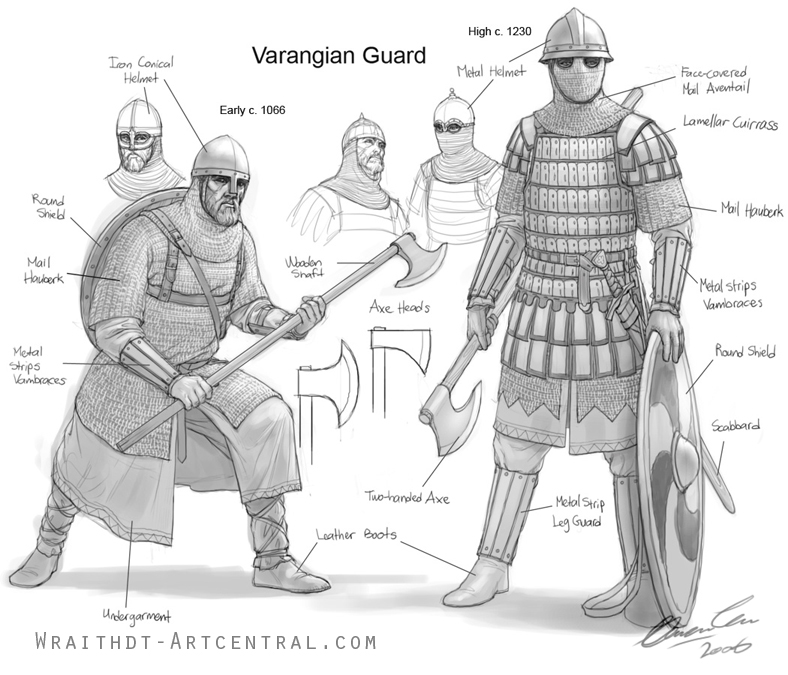
The most elite of the Norse Auxiliaries are given a chance to convert to Islam and become part of the Caliph's Guard, the Mamluks. These guardians are provided with the status of nobility, and the most advanced armor that the Goverment can provide. These elites number no more than 100 at a time, and follow the Caliph as his personal retinue. They are effectively the personal property of the Caliph, existing as Slave-Soldiers, abet with significantly more freedoms than the average slave, but obliged to submit to every whim and desire of the Caliph, until their retirement. Mamluks serve until the age of 60, after which they are released from their contract of slavery and given a grant of land, a pension, and status of Nobility to them, their immediate family, and descendants.
The Armor of the Mamluks is High Quality steel Lamellar, worn over a mail hauberk. Thier most distinguishing feature is arguably their mail masks, which are said to function in removing their individuality while in service, reinforcing their status as extentions of the Caliph. They function as Guardsmen to the Caliph and of his personal property. One group of 12 function as personal escorts on his trips into public, the others acting as hired security of his home, and in other places of importance, such as the Kaaba and the Sacred Mosque.
Other:N/A

